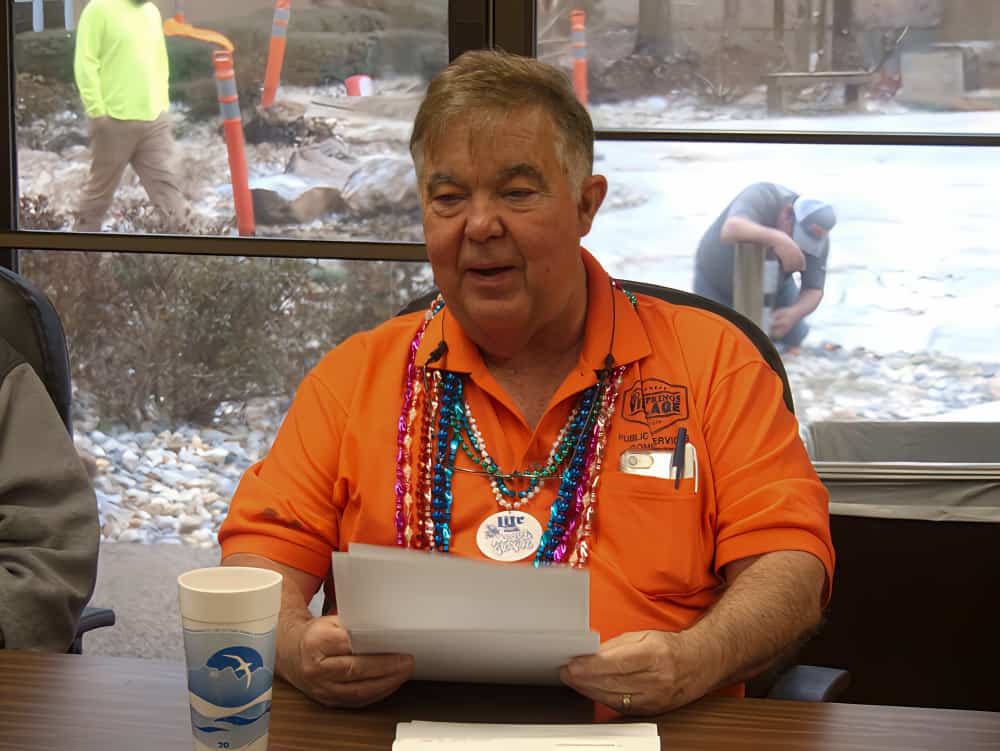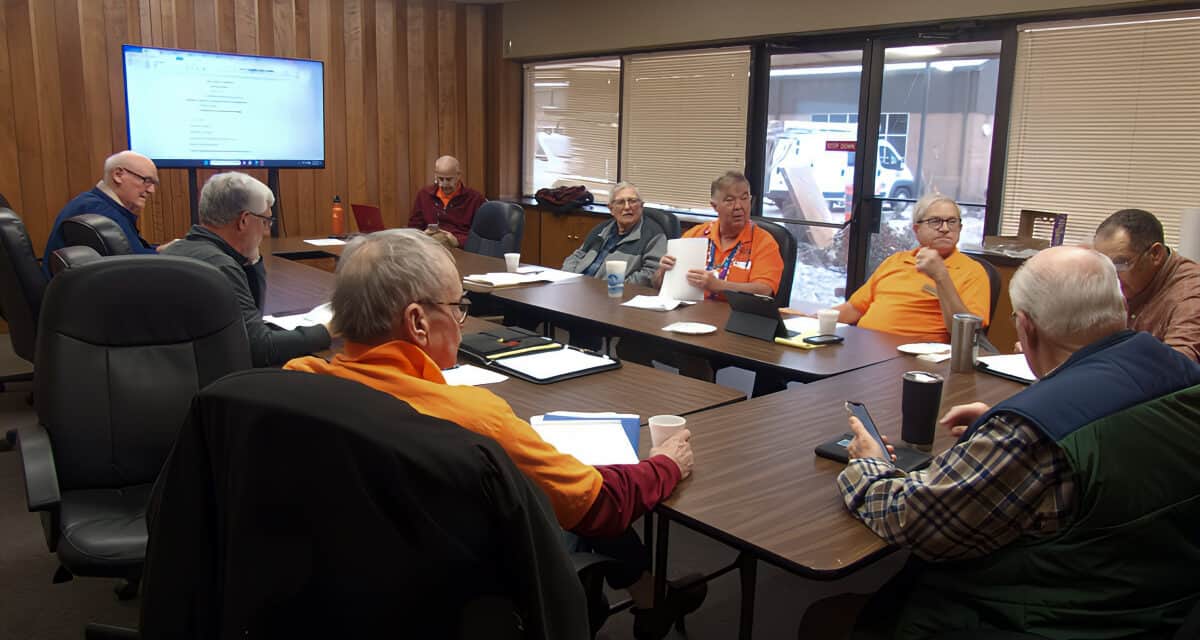The Hot Springs Village Public Services Committee met at 9:30 a.m. on Thursday, February 8, 2024, in Room 3 at the Coronado Community Center. Committee Chair David Childs treated the committee members to a Mardi Gras King Cake and Valentine’s cookies.
Childs explained the tradition of the Mardi Gras King Cake. The story behind the baby in the cake is that whoever gets the baby in their piece of cake will have good luck for the rest of the year. He said he removed the baby from the cake so no one would chip a tooth or choke on it.
According to Better Homes and Gardens, “In the 1940s, a baker named Donald Entringer solidified the baby-in-the-cake tradition when a traveling salesman approached him with an offering of small porcelain dolls. Entringer began baking the porcelain dolls into his king cakes to symbolize baby Jesus, and the tradition was born.”

Other committee members attending were John Sowers, Committee Secretary, Keith Buchanan, Philip Matone, George Parker, Jim Patton, Michael Riley, and Walt Black.
Board Member and Committee Liaison Larry Siener was in attendance. Board Member Bruce Caverly was also present.
Rolland White, Committee Vice Chair, Drew Kahle, and David Whitehead were excused absences.
Also present were staff: Public Services Director Ken Unger, Water and Wastewater Superintendent Chris Boutzale, and Water and Wastewater Line Maintenance Superintendent Larry Hefler.
Guests at the meeting were Villager Steve Klomsten, a former committee member, and Villager Tony Hofstede.
Invited to the meeting by Matone, Klomsten worked for a large Milwaukee construction company, installing ten miles of both water mains and sewer mains per year. He is an expert in this type of work and pipes. In particular, Klomsten has extensive experience working with HDPE pipe. (See HDPE discussion below.)
Patton made an addition to the agenda. He represents the Public Services Committee on the Tri-Lakes Metropolitan Planning Organization Technical Advisory Committee (TAC)). This TAC only deals with Garland/Hot Springs County issues. Saline County has its own TAC. The main TAC functions are to review projects, safety measures, and up to 5-year budget planning, done in coordination with the State of Arkansas Department of Transportation (ARDOT). It is a federal requirement to have this committee functioning to review and vote on all regular and unforeseen issues arising during the physical year to qualify for federal funds.
Public Services replaced one-third of most problematic water mains in the past year and has more replacements planned.
Pending committee approval, Unger said he would bring motions before the HSVPOA Board of Directors on February 21 to proceed with the GarNat design and project and to execute the Gancho Way and Galeon Way water main replacements. These are not full-street main replacements but will replace “areas with repeated failures over the past ten or twenty years.” When he took the position as Public Services Director, Unger asked for the list of the most problematic mains in the Village. Repeatedly bursting, these mains resulted in a lot of water loss, staff resources, and disruption to the community. Unger said that they have completed the replacement of around one-third of the most problematic water main lines. Completing the Gancho and Galeon Way Projects will tick two more items off the list.
“There are nuances to the [Gancho and Galeon Way] water lines. They are under high pressure. One of the lines involves the replacement of a pressure-reducing valve. We are going to replace a couple of pressure-reducing valves on the other side of these segments. The contours of the ground are such that the vertical and horizontal twists and turns of the roads” result in a lot of bending stress to the existing PVC pipes. Unger said they probably were not installed with adequate elbows or bends, forcing the line into the trench as they dug. “When we have a main break, the line actually snaps.”
HIGH-DENSITY POLYETHYLENE PIPE (HDPE) pipes may be used in these two main replacement projects.
What is a HDPE pipe?
HDPE is a flexible plastic pipe used for fluid and gas transfer and is often used to replace aging concrete or steel mains pipelines. Made from thermoplastic HDPE (high-density polyethylene), its high level of impermeability and strong molecular bonds make it suitable for high-pressure pipelines. The pipe joints are often joined using high-temperature electrofusion machines.
Which is more durable, HDPE or PVC?
PVC is a durable vinyl polymer, whereas HDPE is a polyethylene thermoplastic made from petroleum. Both pipes are strong through high temperatures. When comparing failure ratings when exposed to events like rain, stress, wind, heat, or cold, HDPE is proven to be more durable.
HDPE bid was lower than the PVC bid
Unger said it was more economical to go with HDPE when they received the bids. Not only are installation and cost of the pipe lower, but fewer joints are needed with HDPE. Around a decade ago, the Village replaced a main running from the Cortez Lift Station to the Mill Creek Wastewater Treatment Plant with HDPE lines. This line has held up well.
Pending board approval, GarNat Engineering will design the two main water replacement projects (Gancho Way, 8” dia pipe, 1240 LF; and Galeon Way, 6“ dia pipe, 1400 LF). The original estimated construction cost of over $368,000 may be reduced by about 35 percent depending on the contractor chosen and the required training and certification.
The engineer felt that the best solution would be to use HDPE pipe instead of PVC.
Steve Klomsten offers HDPE guidance.
Klomsten provided HDPE guidance at the meeting, emphasizing the importance of having certified personnel with proof of successful work and having a preconstruction conference. The best fusing is done above ground using quality machines, and the work must be inspected and tested. Klomsten has agreed to continue to offer his expertise in this area to Public Services.
Klomsten said, “I like HDPE a lot for use in unstable grounds.”
Unger said they would monitor the HDPE work and then do a smaller main in-house after receiving the necessary training and certification. Under Unger’s guidance, Public Services is moving towards doing more in-house work for cost-effectiveness.
Design of major HSV water/sewage projects
Crist Engineers are designing the major HSV water/sewage projects. The estimated design costs are now about $1.6 million. These multi-year projects involve both sewage plants, the water plant, and sewage/water line repairs and replacements throughout HSV. This will be funded in 2024 and 2025.
Safety Report by George Parker
Parker provided the January 2024 HSV Public Safety report showing 13 reported accidents, nine single vehicles, and four multi-vehicles. Seven of the accidents resulted from drivers losing control.
Ken Unger is compiling a list of projects completed.
Unger is coming up on his HSVPOA second anniversary date and is compiling a list of significant projects completed over the past two years. The compilation will also include what he has planned for 2024.
While Unger has made great advances in eliminating many sewage overflows in the line, this has resulted in more overflows at the Mill Creek Sewage Treatment Plant. This is due to an influx of more material, and plant overflows were expected. To handle an increase in sewage, Crist Engineering has recommended decommissioning Mill Creek and rerouting all sewage to Cedar Creek Wastewater Treatment Plant. Due to our increased needs, this is the most economical way to handle sewage movement and processing. Upgrading both plants could cost between $36 M and $47 M. Consolidation estimates are $27 M to $40 M. Unger said he is trying to save money by installing some force mains in-house, if possible. Unger estimates the savings of self-performance (in-house work) to be between $3 M and $4 M.
Consolidating the two plants has the added benefit of reducing operational costs, including chemicals, electricity, etc.
Additional comments
Siener said that the latest winter storm required the use of large amounts of sand and liquid deicers on unsafe roads. Many trees blocking roads had to be removed. Also, many vehicles that slid off icy roads had to be recovered. We perhaps need to ask the POA Board of Directors to adjust the Public Services budget. The dollar impact of this unforeseen winter storm needs to be determined.
Also, at least 20 HSV water users consume large amounts of water over and above what would normally be expected. An effort to encourage water conservation will be taken.
NEXT MEETINGS: Thursday, February 22, 2024, Working Session, 9:30 A.M., Rm 3, Coronado Center, and Thursday, March 14, 2024, Public Meeting, 9:30 A.M., Rm 3, Coronado Center.
By Cheryl Dowden
CONTACT INFORMATION FOR HSVPOA PUBLIC SERVICES DIRECTOR
Ken Unger
Director Public Services
Hot Springs Village
501-226-9609
Kunger@hsvpoa.org
We are glad you dropped in to visit Hot Springs Village Gazette. Please comment below if you like; we love hearing your opinions. Thank you for keeping the comments polite and on topic. Please use your first and last real name.
We provide news and promote local businesses, events, and organizations! Let us know if we can help. We also accept opinion pieces and articles from guest authors.
We can be contacted through this website; click the contact button and let us know your thoughts. Be sure to bookmark this site and come back to visit with us often, as our content frequently changes. If you are an HSV Property Owner, click here to visit and join a private property owner Facebook Group. Thanks!
Click here to contact the HSV Gazette.
Click here to visit the Explore the Village website.



The water industry estimates that an average person uses 3,000 gallons of water monthly and the average household has two or more people, which is an average of 6000 or more gallons per month per household. Hot Springs Village charges more than twice the average American water/sewer bill and it includes only 5000 gallons every other month, which is less than half of average American household usage.
Hi Katherine. Thank you for commenting. According to this website: , the national average monthly water and sewer bill is $102. In Hot Springs Village, we are billed for two months at a time, but our combined water and sewer bill is approximately $60 monthly. Thanks again. – Cheryl Dowden
The chart on that same website shows the average monthly water/sewer bill for Arkansas is $26 and likely includes more than twice as much water.
We are talking about a combination of water and sewer. 35 years ago, in a different location, I paid $45 a month for sewer, alone. My water bill was a lot less. The POA is not making a profit on water and sewer, as they not only incur normal operating costs, but there are main breaks and other things in the system that require repairs. There are problems with both systems, but our Public Services Director is working with Crist Engineering on overcoming these issues. Some of them I have discussed on this website and I will be talking about more. I don’t want to see my bills go any higher, either, but we might as well face the fact that it is inevitable that our water and sewer bills will go up. Because of AR Act 605, the two utilities must be self-sufficient and we will soon no longer have the option of subsidizing them with our assessment dollars .
According to WiseVoter.com, only nine states in the USA have higher average water/sewer charges than Hot Springs Village (which start at $60/mo).